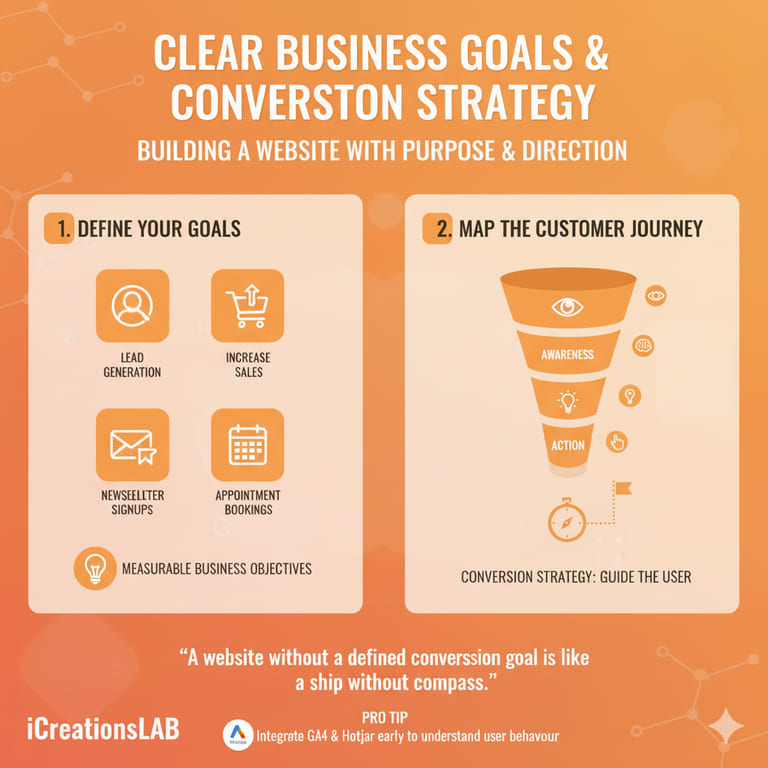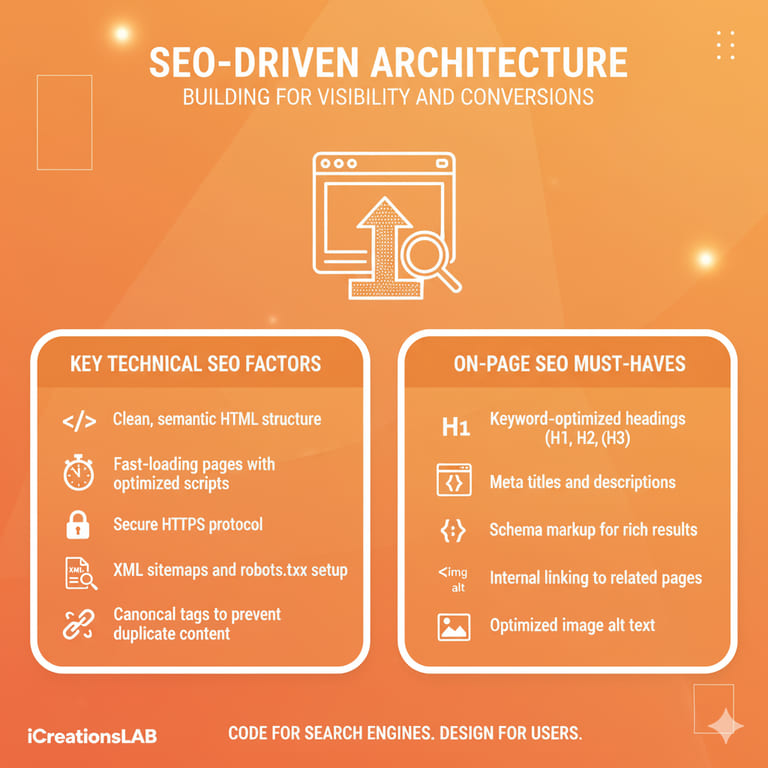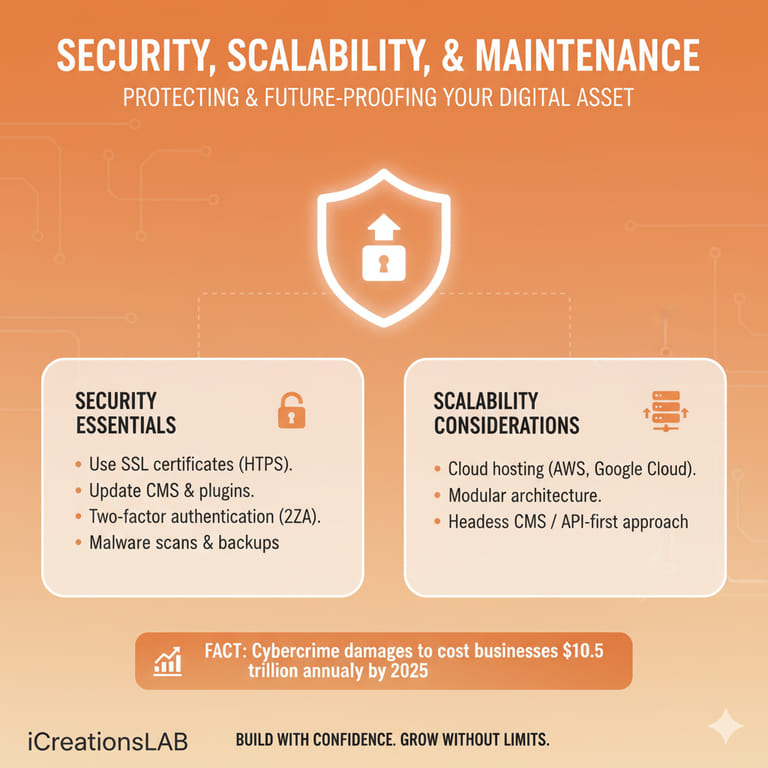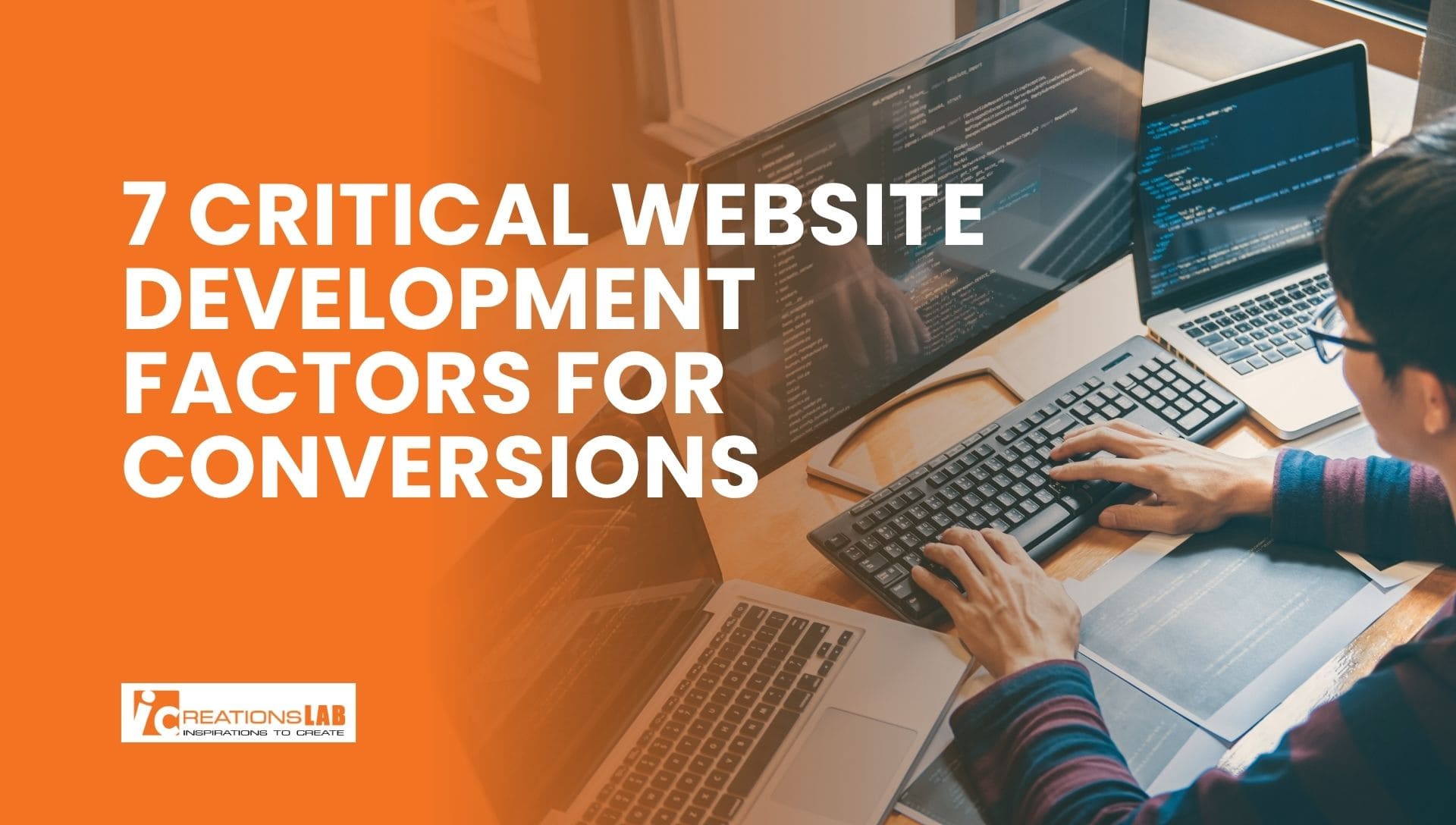In today’s digital-first business environment, your website is not just a digital brochure — it’s your most powerful conversion engine. Whether you’re a startup or an established brand, investing in website development that truly drives conversions can determine whether your visitors become paying customers or disappear into the internet void.
In this article, we’ll dive deep into the seven critical factors every business must get right during website development to achieve tangible business results — increased leads, sales, and long-term customer loyalty.
1. Clear Business Goals and Conversion Strategy

Before you write a single line of code, your website development project must begin with clarity — what do you want the site to achieve?
Too many websites look beautiful but fail to convert because they lack direction. A conversion-focused site starts with measurable business goals such as:
- Generating qualified leads
- Increasing online sales
- Encouraging newsletter signups
- Boosting appointment bookings
Once goals are set, your conversion strategy defines the journey users take to reach them. Use analytics to map out the customer funnel — awareness, interest, decision, and action. Every page should guide visitors toward the next logical step.
“A website without a defined conversion goal is like a ship without a compass — beautiful, but directionless.”
Pro Tip:
Integrate tools like Google Analytics 4 (GA4) and Hotjar early in your development process. They help you understand user behaviour and identify where potential customers drop off.
See More: Think Your Website Looks Fine? Here’s What a Top Web Design Company Sees Differently
2. User Experience (UX) That Builds Trust
In 2025, user experience is the new currency of online success. A slow, confusing, or visually cluttered website can kill conversions instantly.
Good UX begins with understanding your audience. Conduct surveys, user testing, or create buyer personas to tailor your design and content to what users actually need.
Key UX Principles for Higher Conversions:
- Simplicity: Keep navigation intuitive and clean.
- Consistency: Maintain a consistent layout, font, and color palette across all pages.
- Accessibility: Ensure your website is usable by everyone, including people with disabilities.
- Visual Hierarchy: Highlight calls-to-action (CTAs) with contrasting colors and ample white space.
Example:
A study by Forrester Research found that a well-designed user interface can increase conversion rates by up to 200%, while a better UX design can yield conversion rates up to 400%.
See More: Top 10 SEO Tips for New Websites
3. Mobile Responsiveness and Page Speed
Over 70% of website traffic now comes from mobile devices. If your website isn’t optimized for mobile, you’re already losing customers.
Mobile responsiveness ensures that your content, images, and navigation adapt seamlessly to any device. Beyond usability, Google’s Core Web Vitals now make mobile performance a ranking factor — directly influencing your visibility and conversion rate.
Optimization Checklist:
- Use responsive frameworks (like Bootstrap or Tailwind CSS).
- Compress images with WebP format.
- Implement lazy loading for videos and images.
- Use content delivery networks (CDNs) for faster global loading.
“A one-second delay in page load time can lead to a 7% reduction in conversions.” – Akamai Research
Pro Tip:
Use Google PageSpeed Insights or GTmetrix to benchmark performance and address bottlenecks during development.
See More: Why Website Speed Matters for Google Ranking
4. SEO-Driven Architecture

Building a website that converts starts with SEO-first development. Without search visibility, even the most elegant site won’t attract visitors to convert.
Your development process should include both technical SEO and on-page SEO best practices:
Key Technical SEO Factors:
- Clean, semantic HTML structure
- Fast-loading pages with optimized scripts
- Secure HTTPS protocol
- XML sitemaps and robots.txt setup
- Canonical tags to prevent duplicate content
On-Page SEO Must-Haves:
- Keyword-optimized headings (H1, H2, H3)
- Meta titles and descriptions
- Schema markup for rich results
- Internal linking to related pages
- Optimized image alt text
Fact:
According to HubSpot, 75% of users never scroll past the first page of Google results — which means SEO and development must go hand-in-hand.
See More: How to Register a Domain Name in Singapore (2025 Guide)
5. Conversion-Optimized Design (UI + CTA Strategy)
Your website’s design should not only be beautiful but also strategically persuasive. Visuals guide user emotions — and emotions drive action.
UI Elements That Influence Conversions:
- Hero Section: Use strong headlines and visuals that express your value proposition clearly.
- CTAs: Every page should have a single, clear action (e.g., “Book a Consultation”, “Get a Quote”).
- Trust Signals: Add testimonials, certifications, and client logos to build credibility.
- Forms: Keep them short and frictionless — ask only for essential information.
Example:
Changing a CTA button color from gray to orange increased conversions by 32% for one e-commerce brand, according to HubSpot case studies.
“Design without purpose is decoration. Design with data is conversion.”
Pro Tip:
Use A/B testing to experiment with different layouts, colors, and CTA placements. Real data beats assumptions.
See More: How to Register a Domain Name in Singapore (2025 Guide)
6. Integration with Analytics and Marketing Tools
A conversion-focused website doesn’t stop at design — it integrates with your marketing ecosystem.
During development, plan how your site will connect with CRM systems, email marketing tools, and analytics dashboards. These integrations allow you to track performance and retarget users effectively.
Essential Integrations:
- CRM Integration: HubSpot, Salesforce, or Zoho CRM
- Email Automation: Mailchimp or ActiveCampaign
- Analytics Tools: Google Analytics 4, Tag Manager
- Advertising Pixels: Meta Pixel, Google Ads Conversion Tracking
With integrated data, you can:
- Track every user touchpoint
- Automate remarketing campaigns
- Identify top-performing pages and improve them
Statistic:
Companies that leverage customer data effectively are 23 times more likely to acquire customers and 6 times more likely to retain them (McKinsey).
See More: 10 Best Website Design & Development Companies 2025
7. Security, Scalability, and Maintenance

No matter how visually stunning your site is, it must be secure, scalable, and easy to maintain. A single security breach can destroy user trust — and your brand reputation.
Security Essentials:
- Use SSL certificates (HTTPS).
- Keep your CMS, plugins, and frameworks updated.
- Implement two-factor authentication for admin logins.
- Schedule regular malware scans and backups.
Scalability Considerations:
- Choose hosting that grows with your business (e.g., AWS, Google Cloud).
- Opt for a modular architecture — so new features can be added easily.
- Use headless CMS or API-first approaches for future flexibility.
Fact:
Cybercrime damages are expected to cost businesses $10.5 trillion annually by 2025 (Cybersecurity Ventures).
See More: Best Website Builders Compared: Which One Fits Your Business?
7 Key FAQs About Website Development for Conversions
What is the main goal of website development for businesses?
The main goal of website development is to build a digital platform that drives real business outcomes — not just traffic.
A professionally developed website should:
- Reflect your brand identity clearly and consistently.
- Provide a seamless user experience (UX) to keep visitors engaged.
- Guide users toward specific conversion actions, such as requesting a quote, signing up for a newsletter, or making a purchase.
When done right, your website becomes a 24/7 sales representative, turning visitors into paying customers automatically.
According to Stanford Web Credibility Research, 75% of users judge a company’s credibility based on its website design, which means development decisions directly influence trust — and conversions.
How long does a website development project take?
A typical website development project takes 4 to 12 weeks, depending on scope and complexity.
- Small business websites: 4–6 weeks (basic pages, CMS setup, responsive design).
- Corporate or eCommerce websites: 8–12 weeks (custom UI, integrations, and testing).
- Enterprise-level web applications: 3–6 months (complex backend systems and API integrations).
The timeline includes several critical phases:
- Planning & Research: Defining goals, target audience, and sitemap.
- Design & UX: Creating wireframes and visual prototypes.
- Development: Coding frontend and backend systems.
- Testing & Optimization: Checking performance, SEO, and cross-device responsiveness.
- Launch & Maintenance: Deploying securely and monitoring user behavior.
A well-planned development schedule ensures that your site launches without bugs, speed issues, or conversion leaks.
See More: Custom UI UX Design Solutions for Businesses in 2025
How does website speed affect conversions?
Website speed is one of the strongest predictors of conversion success. Users expect fast, seamless experiences — and every second counts.
- A 1-second delay can reduce conversions by 7% (Akamai).
- 53% of visitors abandon a site that takes more than 3 seconds to load (Google).
- A site that loads in under 2 seconds enjoys a 50% longer average session duration (Portent Study).
Speed impacts user satisfaction, SEO ranking, and trust. Slow websites signal unreliability, especially in eCommerce where users are ready to buy.
To improve speed during development:
- Use lightweight frameworks and optimized code.
- Compress images using next-gen formats like WebP.
- Enable browser caching and Content Delivery Networks (CDNs).
- Minify CSS and JavaScript files.
A fast-loading website keeps users engaged longer — and more engagement means more conversions.
Why is mobile optimization important for conversions?
Mobile optimization ensures your website works perfectly on smartphones and tablets, where over 70% of global web traffic originates (Statista 2025).
If your site isn’t responsive, users will struggle with zooming, scrolling, and misaligned buttons — leading to higher bounce rates and lost sales opportunities.
Mobile-Optimized Sites Offer:
- Better usability: Simplified menus, larger buttons, and easy navigation.
- Faster load times: Mobile-first coding practices reduce page weight.
- SEO advantage: Google ranks mobile-friendly websites higher in search results.
- Higher conversions: Mobile users are often ready to act (e.g., call, order, or book immediately).
For example, a restaurant site with click-to-call buttons and quick menu access can double mobile conversion rates compared to non-optimized sites.
In short, if your website isn’t mobile-first, it’s missing most of your audience — and your conversions.
See More: How Custom Web Development Services Can Skyrocket Your Sales
What role does SEO play in web development?
SEO (Search Engine Optimization) is the foundation that allows your website to be discovered organically. Without SEO-focused development, your site might look great but stay invisible on Google.
SEO in Website Development Involves:
- Technical SEO: Optimizing page speed, clean URL structure, and secure HTTPS setup.
- On-Page SEO: Using proper heading tags (H1–H3), meta titles, and descriptions with relevant keywords.
- Schema Markup: Adding structured data to help search engines understand your content.
- Mobile Optimization: Google indexes mobile-first sites for ranking.
When developers and SEO specialists work together, the result is a website that’s both technically sound and search-friendly — bringing in a steady stream of qualified visitors who are more likely to convert.
Did you know? 68% of online experiences start with a search engine, and websites optimized for SEO generate 14 times more organic traffic than non-optimized ones (BrightEdge).
How can I measure website conversion success?
Tracking conversions is essential to understanding how well your website performs. You can measure success using both quantitative and qualitative metrics.
Key Conversion KPIs:
- Conversion Rate (CR): The percentage of visitors completing your desired action.
- Bounce Rate: The percentage of users leaving after viewing only one page.
- Average Session Duration: How long users stay — the longer, the better.
- Cost per Conversion (CPC): How much you spend to gain one customer.
- Goal Completions: Number of times users sign up, purchase, or inquire.
Use tools like:
- Google Analytics 4 (GA4): For user behavior and conversion tracking.
- Google Tag Manager: For event tracking and button clicks.
- Hotjar or Microsoft Clarity: For heatmaps and scroll analysis.
High-performing websites track and analyze this data weekly or monthly to identify what’s working — and optimize continuously for higher ROI.
See More: Professional Custom Web Development Services for Businesses in 2025
Should I hire a professional web development company?
Yes — hiring a professional web development agency is a smart investment if your goal is conversions, not just an online presence.
A professional team brings:
- Technical expertise in frameworks (WordPress, Laravel, React, etc.).
- UX/UI design knowledge to craft user-centered interfaces.
- SEO and analytics integration for measurable performance.
- Security and maintenance support to ensure long-term stability.
DIY or low-cost templates may look appealing, but they often lack scalability, SEO optimization, and custom features your business needs to grow.
Fact: Businesses that invest in professional web development achieve 2.5x higher conversion rates and 50% faster growth than those using generic website builders (Clutch Report 2024).
Working with experts ensures your website becomes a strategic business tool — optimized for user experience, visibility, and conversion power.
Build for Conversions, Not Just Clicks
In the digital era, website development isn’t just about looks — it’s about results. Every decision, from layout to backend code, must serve one purpose: turning visitors into customers.
When done right, your website becomes more than an online presence — it becomes a growth engine for your business.
If you’re ready to transform your website into a high-performing conversion machine, it’s time to partner with the experts.
About iCreationsLAB
Founded in 2008, iCreationsLAB is a leading website design and development company in Singapore, specializing in:
- Corporate and eCommerce websites
- Mobile-friendly and CMS-based solutions
- Custom web applications and SEO-driven designs
With a focus on performance, creativity, and measurable results, we help businesses in Singapore and beyond turn their websites into powerful conversion tools.
Let’s build your next website that converts.
Visit www.icreationslab.com to learn more.

